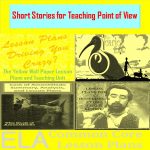Lesson Plan: Teaching Point of View in Literature
Don’t just teach students a list of terms to memorize. Teach them how to implement point of view in their writing.
A New Point of View
After teaching students how to write for an audience and with a purpose, I felt good about myself once again. I called my college professor and told him what a great job I was doing. Then I realized I had not done a good job teaching point of view. In shock, I called my professor back, cussed him out, called the university registrar, demanded a refund, called my travel agent, and cancelled my weekend flight to the Dominican Republic.
I had work to do. I had to devise a lesson plan about teaching point of view. Here’s what I came up with.
Feel free to download this point of view lesson plan before continuing.
Common Core Standards
Teaching point of view satisfies the following ELA Common Core Standards.
RL.9-10.1 Cite strong and thorough textual evidence to support analysis of what the text says explicitly as well as inferences drawn from the text.
L.9-10.2 Determine a theme or central idea of a text and analyze in detail its development over the course of the text, including how it emerges and is shaped and refined by specific details; provide an objective summary of the text.
RL.9-10.3 Analyze how complex characters (e.g., those with multiple or conflicting motivations) develop over the course of a text, interact with other characters, and advance the plot or develop the theme.
RL.9-10.5 Analyze how an author’s choices concerning how to structure a text, order events within it (e.g., parallel plots), and manipulate time (e.g., pacing, flashbacks) create such effects as mystery, tension, or surprise.
RL.9-10.6 Analyze a particular point of view or cultural experience reflected in a work of literature from outside the United States, drawing on a wide reading of world literature.
W.9-10.5 Develop and strengthen writing as needed by planning, revising, editing, rewriting, or trying a new approach, focusing on addressing what is most significant for a specific purpose and audience. (Editing for conventions should demonstrate command of L.9-10.1-3.)
Getting Started

These steps will get your point of view lesson off to a good start.
- Show two sample passages: one written in first person point of view; one written in third person point of view.
- Instruct students to determine points of view by identifying pronouns used by the narrator.
- Discuss why one point of view would be more effective than the other, and what the individual weaknesses of each point of view are.
- Discussion should cover the following ideas: 1) Point of view is the position from which the narrator views its subject; 2) First person point of view is the more limited, giving only one vantage point. It does, however, forge a bond between reader and narrator; 3) Third person point of view is more versatile.
Two Point of View Lesson Options
These procedures will have students applying their knowledge of literature and involves revising essays.
Option 1
- Instruct students to read their drafts and answer the following questions: What point of view did you use? How do you know? Which character tells the story? Why did you choose this particular point of view?
- Students must consider audience and purpose and determine which point of view would be more effective for the intended audience.
- Instruct students to rewrite their first paragraph in a different point of view.
- In groups of 2-4, instruct each student to read both versions. Group members will help determine which point of view works better.
- For assessment, collect both paragraphs and evaluate them based on how well they used each point of view.
Option 2
- Assign groups of four.
- Assign each group a different scene.
- Each person in the group will write from a different point of view: 1st person, third person omniscient, third person limited, or third person dramatic.
- Have groups evaluate the most effective point of view.
- Read it to the class.
Teaching the Elements of Literature
Understanding literary elements is necessary for literary analysis. These short stories will help you teach literary elements.
- The Best American Short Stories
- Short Stories for Teaching Theme
- Short Stories for Teaching Irony
- Short Stories for Teaching Symbolism
- Short Stories for Teaching Conflict
- Short Stories for Teaching Foreshadowing
- Short Stories for Teaching Imagery
- Short Stories for Teaching Characterization
Last Updated on December 2, 2016 by Trenton Lorcher
Share This: